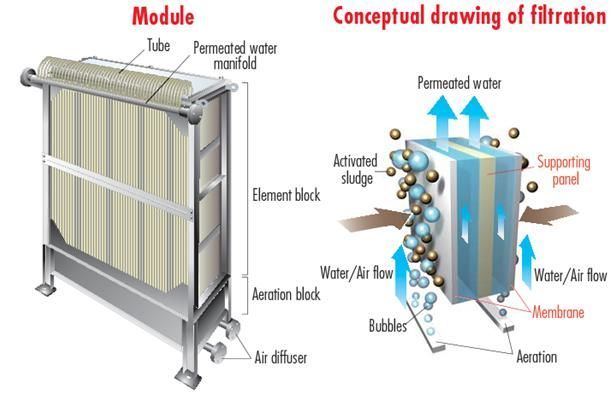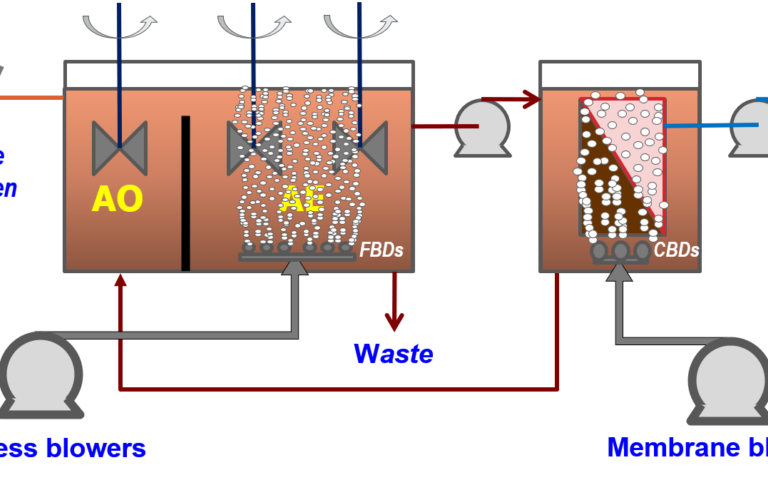The Economic Benefits of Installing a Membrane Bioreactor for Your Facility
The Economic Benefits of Installing a Membrane Bioreactor for Your Facility
Blog Article
Exactly How Membrane Bioreactors Are Transforming Water Filtration Systems
The introduction of membrane layer bioreactors (MBRs) stands for a considerable advancement in the area of water filtration, combining biological therapy procedures with cutting-edge membrane filtering technologies. As global water deficiency heightens, the role of MBRs in assisting in drinkable water reuse and lasting water administration comes to be significantly crucial.
Summary of Membrane Bioreactors
Membrane layer bioreactors (MBRs) stand for a considerable advancement in water purification technology, as they incorporate organic therapy procedures with membrane filtering. This integration improves the effectiveness of wastewater therapy by utilizing microorganisms to weaken natural pollutants while all at once employing semi-permeable membranes to separate cured water from put on hold pathogens and solids.
The MBR system usually consists of an organic activator where the microbial population metabolizes contaminants, followed by a membrane layer purification unit that maintains biomass and permits only clean water to pass through. This twin functionality causes higher effluent quality contrasted to standard treatment techniques. MBRs can be run in both batch and continual flow modes, supplying versatility in style and application.
Additionally, MBRs are defined by their small impact, making them ideal for city setups with area constraints. Membrane Bioreactor. They likewise make it possible for the recovery of water for reuse, thus adding to water sustainability campaigns. While MBR modern technology has gotten appeal in commercial and community applications, its operational complexities and energy needs demand cautious consideration throughout execution. Overall, MBRs are at the leading edge of improving water treatment efficiency and quality, showcasing the capacity for innovative services in environmental monitoring.
Benefits of MBR Innovation
The integration of organic therapy with membrane layer purification uses various advantages for water purification procedures. Among the key advantages of Membrane Bioreactor (MBR) innovation is its capability to properly eliminate both organic and inorganic pollutants, leading to high-quality effluent. The membrane layers function as a physical barrier, avoiding put on hold solids and microorganisms from travelling through, which enhances the general safety and integrity of cured water.
Additionally, MBR systems require a smaller impact compared to conventional therapy approaches, permitting much more effective space application. This portable design is particularly useful in urban setups where land is restricted. MBRs also show functional adaptability, suiting differing influent high qualities and circulation prices without significant performance degradation.
Moreover, the process provides improved nutrient elimination capabilities, particularly for nitrogen and phosphorus, which are critical for protecting against eutrophication in obtaining waters. The minimized sludge manufacturing linked with MBR technology also translates to lower disposal expenses, making it a cost-effective service in the long run - Membrane Bioreactor. Overall, the advantages of MBR modern technology setting it as a leading choice for innovative and sustainable water purification systems, addressing both ecological and financial concerns
Applications in Water Filtration
Applications of Membrane Bioreactor (MBR) innovation in water filtration are impactful and diverse, addressing different therapy requires throughout multiple industries. MBRs properly integrate organic treatment processes with membrane filtering, making them suitable for local wastewater therapy, industrial effluent administration, and also drinkable water reuse efforts.
In community setups, MBRs are significantly used to boost the my blog quality of treated wastewater, permitting conformity with rigorous discharge guidelines and promoting the recycling of water for watering and non-potable usages. Their compact layout additionally makes them ideal for urban settings where space is restricted.
Industrially, MBR modern technology is made use of to treat procedure water and wastewater, particularly in fields such as food and drink, drugs, and textiles. By successfully getting rid of impurities and suspended solids, MBRs assist sectors lessen ecological influences while recovering important sources from wastewater streams.
Additionally, MBRs are gaining grip in decentralized water therapy applications, where small-scale systems can be released in remote locations or creating areas. This adaptability allows areas to achieve sustainable water administration options, improving accessibility to tidy water while decreasing reliance on traditional therapy methods.
Instance Research Studies and Success Stories

In an additional instance, a textile production center in Bangladesh embraced MBR technology to resolve its wastewater obstacles. The system decreased chemical oxygen demand (COD) degrees from 1,200 mg/L to less than 100 mg/L, therefore satisfying regulative standards and significantly minimizing ecological effect.
The University of Cape Town's MBR installment has actually shown efficient in dealing with greywater for non-potable reuse on campus. This job not just conserves drinkable water yet likewise works as an academic model for sustainable practices.
Furthermore, a fish and shellfish handling plant in Norway used MBR technology to deal with effluents having high levels of natural issue, attaining over 90% contaminant removal. These study highlight MBR modern technology's convenience and its essential role in enhancing water quality throughout varied applications.
Future of Water Therapy Solutions
As international water scarcity and pollution read the full info here difficulties magnify, ingenious water treatment remedies are ending up being increasingly important to make certain sustainable access to clean water. The future of water treatment depends on the assimilation of innovative technologies that enhance the efficiency and effectiveness of purification processes. Membrane layer bioreactors (MBRs) go to the forefront of this development, combining biological treatment with membrane filtration to create high-grade effluent suitable for numerous applications.

Arising fads such as source recovery from wastewater, including nutrients and energy, will better change treatment facilities right into environment-friendly centers. Furthermore, developments in nanotechnology and membrane materials assure boosted performance and longevity of purification systems.

Verdict
In final thought, membrane layer bioreactors represent a considerable development in water purification technologies, effectively combining biological treatment with innovative membrane layer filtering. The numerous benefits, including boosted effluent high quality and lowered spatial demands, make MBRs especially ideal for metropolitan applications. Their duty in drinkable water reuse and lasting water administration highlights their significance in dealing with international water scarcity challenges. Proceeded r & d will additionally enhance the efficiency and adoption of MBR innovation, making certain a resistant future for water therapy services.
The introduction of membrane layer bioreactors (MBRs) stands for a considerable advancement in the field of water purification, combining organic therapy processes with advanced membrane filtering modern technologies. As worldwide water shortage increases, the function of MBRs in promoting drinkable water reuse and lasting water management ends up being progressively critical. They also allow the healing of water for reuse, thus adding to water sustainability efforts.As global water scarcity and pollution obstacles magnify, ingenious water therapy services are becoming progressively necessary to guarantee lasting access to tidy water. Their role in drinkable water reuse and sustainable water monitoring highlights their relevance in attending to international water shortage read this obstacles.
Report this page